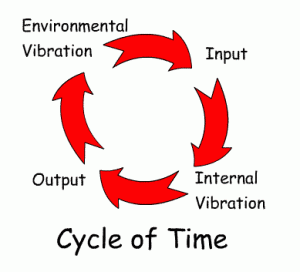 Time manifests as a fractal structure. The smallest unit of time is also the smallest unit of matter. Every atom has a frequency, a cyclic tone that represents one unit of time. Each cycle or unit of time takes input compares it to memory and outputs the result. This memory is not a static pattern, but is dynamic, vibrating in sync with the environmental variables. If the pattern of the input matches the pattern stored in memory, the field doesn’t react, it continues to vibrate normally, but if the input doesn’t match what is anticipated by memory, a perturbence is created in the field. Like a stone pitched in a pond, the waves spread out through the system, carrying information about the mismatch to all points. Not only is the location of the mismatch clearly stated by the arc of the wave, but the “shape” of the mismatch is carried by the shape of the wave. In this way, the whole keeps track of its units in real time.
Time manifests as a fractal structure. The smallest unit of time is also the smallest unit of matter. Every atom has a frequency, a cyclic tone that represents one unit of time. Each cycle or unit of time takes input compares it to memory and outputs the result. This memory is not a static pattern, but is dynamic, vibrating in sync with the environmental variables. If the pattern of the input matches the pattern stored in memory, the field doesn’t react, it continues to vibrate normally, but if the input doesn’t match what is anticipated by memory, a perturbence is created in the field. Like a stone pitched in a pond, the waves spread out through the system, carrying information about the mismatch to all points. Not only is the location of the mismatch clearly stated by the arc of the wave, but the “shape” of the mismatch is carried by the shape of the wave. In this way, the whole keeps track of its units in real time.
What makes time a fractal is that this cycle of input, comparison and output is repeated throughout biological systems, regardless of scale or implementation. All cells, organs, creatures, social organizations and ecosystems, use this fundamental process to interact with their environment. The fundamental vibrations are in harmony from atoms all the way up to galaxies and beyond.
For those who want a more scientific explanation, The Fractal Topology of Time,
A dissertation defense by Kerri Welch at the California Institute of Integral Studies, Feb. 12, 2010.